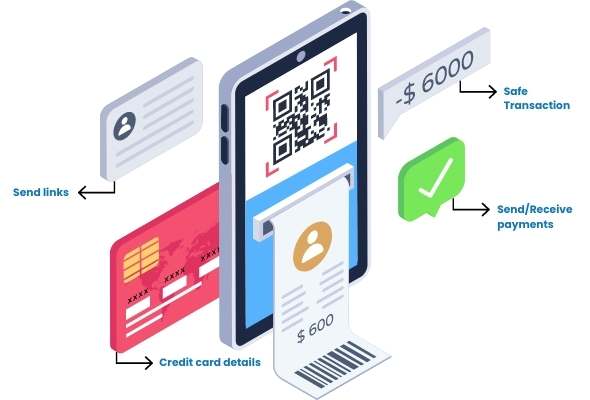
What are the Merchant Benefits of Using Payment Links
Whether you sell online or not, you’ve probably spent a lot of time and effort getting customers to the point of payment. So, it should be simple to accept their payments, right?
Absolutely! That’s why a payment link can be extremely useful in some situations, such as when you don’t have access to card swipe devices or need to accept B2B payments electronically. Payment links are a wonderful alternative for executing transactions fast and easily in these (and other) situations.
Businesses are realizing the benefits of going digital and are allowing for online sales where the payment process is one of the most important aspects of a successful sale, and you must approach it carefully to ensure that your consumers have a positive experience with it.
Table of Contents
What is a payment link?
A payment link is essentially a payment technique that allows you to request and accept online payments from consumers outside of your typical online business. It’s usually powered by one of the prominent payment systems, which assures that both merchants and customers’ payments are secure. It also provides versatility in terms of how it can be used. Wherever you sell online, they can be an email invoice, a social network company page, basic checkout pages on a website, or even channels in messengers.
How do payment links work?
Customers are sent an e-mail, SMS, or web link with a “Pay Now” or “Pay Invoice” option. Customers who click the payment button are brought to a payment page that displays the amount owed. They can safely fill up their billing and shipping information, and the transaction is complete.
Who would use payment links?
While some companies may use payment links to receive the majority of their payments, others may only use them on occasion. If you’re a B2B company that sends electronic invoices to customers, for example, you may include payment buttons directly in your invoices to speed up payment.
Alternatively, you could be a tiny B2C business selling at an event without access to card swipe devices or a virtual terminal. You can simply email a payment link to a customer when they are ready to pay. They’ll get it right away on their phone, and they’ll be able to finish the payment details quickly by inputting their credit/debit card number or selecting a payment wallet like Paytm or Google Pay.
Making payments in today’s expanding e-commerce markets should be all about simplicity, security, and speed. There are multiple payment methods that have progressed over time, from cash to cards to digital payments, with each advancement being more convenient and advanced than the previous. Payment links, on the other hand, are a significant mechanism that is gaining popularity and traction.

Here are some of the most important merchant benefits of using payment links to collect money :
Multiple payment methods that are convenient to use

There are multiple payment methods and currencies that customers can choose from when using a payment link. Customers who have already submitted payment information to you will find the page pre-populated with their billing and shipping information; all customers have to do now is click “Pay Now.” Even better, the payment page it directs to is mobile-friendly, making it simple to navigate even on a phone. (Including an eWallet payment option speeds up the process even further.)
Processing time is reduced
For the business, the benefit of payment links is that they no longer need to meet with consumers for payment or wait for a bank transfer, especially for small amounts. They can simply generate a link that is customized with the information of the purchased things and the requested amount, and clients can complete the payment at their leisure. The funds are automatically transferred to the merchants after a successful payment, reducing the inconvenience and eliminating the need for cash.
Lowered overhead costs
Furthermore, receiving payments through a link eliminates the need for any payment devices such as POS terminals or other third-party applications, reducing setup and maintenance costs. Several apps offer a “pay as you go” model, in which merchants pay a per-transaction cost based on usage rather than registration or monthly price. This lowers the hurdle during initiation, especially for small businesses or those who only accept card payments for a small portion of their sales.
Improved customer service
Payment links can be shared on any social media or messaging site, allowing businesses to personalize the transaction by including a message thanking customers or promoting other products. Furthermore, payment links give clients the freedom of choosing from multiple payment methods and paying with their preferred method. As a result, it enhances the overall shopping experience and can be used to cultivate a loyal consumer base.

It's easier to collect payments
You can build a payment link and customize the checkout page with your own branding with minimal IT work. If more payments are made by credit card, it may ease the pressure on your finance or accounting staff and save them time processing checks.
You can collect payments more quickly
Including a “Pay Now” button on an electronic invoice encourages customers to pay right away, rather than waiting for a physical check to arrive. Paying with a credit card not only expedites the payment procedure, but it also informs you instantly if the funds are available. If not, you can display an error message instructing the customer to try another card, which will immediately resolve the problem.
Works on an international scale
It can be used to receive or send money in any currency. Whether it’s for a friend or to pay for a service, the person who receives the payment has the option to accept it and convert it, not to change it to another currency, or to refuse it.
Conclusion
Many people talk about not having enough time in their daily lives. Transferring funds and paying in cash has become a time-consuming process. Streamlining this process by using Payment links, can provide a number of merchant benefits when used.
With the passage of time, society’s pace has progressively developed, responding to new demands that have surfaced. The electronic market is one area where these shifts are becoming more visible. We have only now recognized the significance of online payment.
Like this article?
More To Explore

Why is Internal Audit Important for Strengthening Banking Organizations?
+91 1141182211 IA procedures are the cornerstone of a robust banking system. They act as a powerful tool for banks

What are the Numerous Advantages of Auditing and Assurance Services?
+91 1141182211 Financial transparency, risk management, and improved internal controls are all crucial aspects of a healthy organization. But how

Streamlining the Journey: Making Your CPV Process Faster and More Efficient
+91 1141182211 In today’s competitive landscape, ensuring consistent product quality while maintaining efficiency is paramount. For industries like pharmaceuticals and

